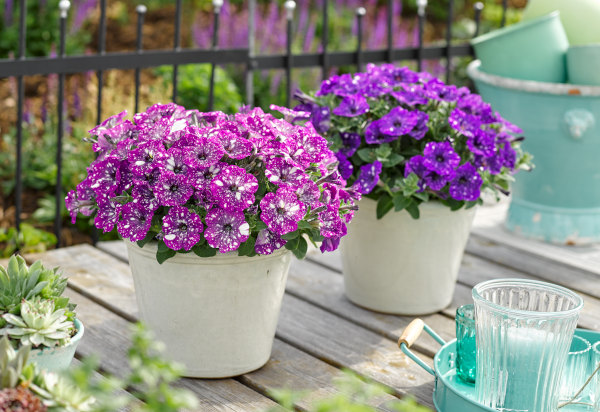How to grow Petunia
If you’ve walked through any European city and seen swathes of large, colourful flowers spilling from lamppost planters, hanging baskets, balconies, or café window boxes, there’s a good chance you’ve encountered Surfinia petunias. Developed in 1987 by Japanese breeders; with their trailing habit, vigorously branching growth, long flowering period, and resistance to rain these plants were something of a breakthrough (at that point there were no other trailing petunias on the market). A Dutch grower introduced them to market, and since then they have become the most widely grown petunia in the world. The name is a blend of surfing (grown en masse in a nursery field, the trailing plants create a wave-like effect), and petunia.
Originally hailing from South America, petunia is a tender member of the potato family – its closest relative being nicotiana and cestrum. Most gardeners treat it as an annual, growing it for its vigorous, free-flowering nature, exceptionally long bloom period, and bright range of colours.
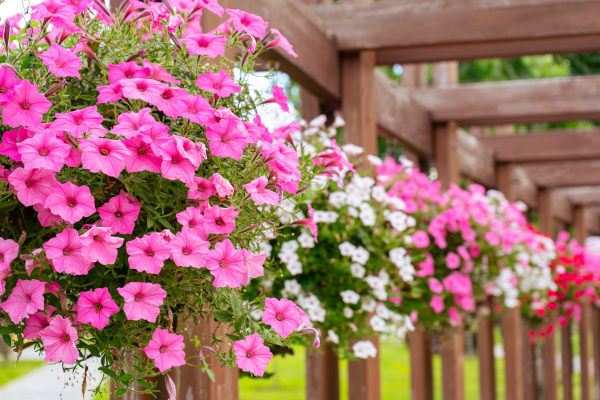
Zantedeschia is a genus of flowering plants from the family Araceae and is native to southern Africa. With a rich history dating back to the Ancient Romans, these deciduous or semi-evergreen perennials have been used as a symbol of celebration. Zantedeschia was Named after Professor Giovanni Zantedeschia, an Italian botanist.
There are two main forms of Zantedeschia: hardy and tender. Hardy forms of the plant can be grown outdoors, enjoy moist soil and full sun or partially shaded conditions - these are known as Arum lilies. Tender forms of Zantedeschia prefer being grown in containers or pots and should be brought inside over the winter - these are known as Calla lilies.
With tuberous flora in all colours from whites, yellows and oranges to deep reds and purples, Zantedeschias are not to be overlooked in any garden, as long as they have sufficient sunlight to grow in.
Ready to learn more about growing Zantedeschia? Read on for all there is to know...

Key Information
Soil pH
Position
Hardiness

Horticultural Divisions-
Habit | |
Bushy | Trailing |
‘Bee’s Knees’ | Amore series |
‘Black Velvet’ | Cascadia series |
Constellation series | Tumbelina series |
Fun House series | Fanfare series |
Go!Tunia series | Fortado series |
Espresso series | Itsy series |
Saguna Patio series | Designer series |
‘Mystical Midnight Gold’ | Pegasus series |
‘Phantom’ | ‘Sweet Miss Marvellous’ |
‘Pinstripe’ |
|
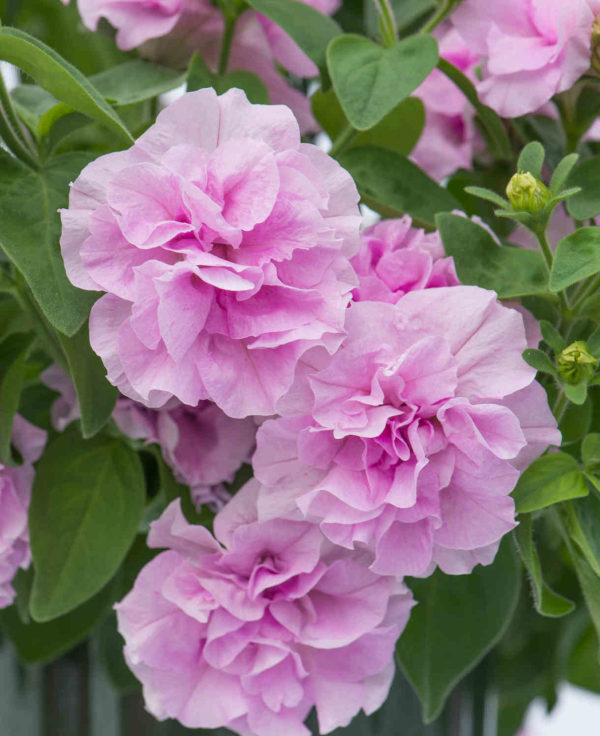
Where & when to plant Petunia
Position - Full sun or partial shade with shelter from strong winds
Soil - Fertile, moist, well-draining. Can be acid, alkaline, or neutral.
Flowering Period - Usually from around June to the first frosts, though some varieties (e.g., the Fun House series) flower earlier, from March until late summer.
Hardiness - H2/ tender. Unable to tolerate temperatures dipping below 1°C.
Petunias hail from warmer climes than ours and can only survive outside in the UK once all risk of frost has passed. This varies from region to region, though tends to be mid to late May. If your plants arrive before it is safe to go outdoors, keep them in a bright, frost-free environment until the time is right. A greenhouse, conservatory, coldframe, or sunny porch or windowsill are all ideal. Just make sure you don’t let them dry out! Small plug plants are best potted up into 9cm pots if they’re going to spend time in a ‘holding zone’ such as this.
Another important thing to note with tender plants like Surfinia petunia is the need to gradually harden them off, rather than suddenly move them outside. This slow toughening up reduces the chances of them going into ‘shock’, which can severely check growth.
The easiest way to do this is by using a cold frame opened in gradual increments over the course of a week or two. Keep the lid closed at night until the last couple of days of the hardening off period.
If you don’t have a cold frame, a bit of horticultural fleece combined with a spot of ‘musical pots’ works just as well. A couple of weeks before you anticipate planting your petunias out, wrap the plants in a couple of layers of fleece and place outside during the day (moving back into a warm, protected environment at night). Do this for a few days then reduce the fleece to one layer. After a few more days like this, remove the fleece completely. If it’s warm enough you can leave outside at night too, though reapply the fleece for this. Towards the end of the hardening off period, leave your plants outside completely uncovered for a couple of days and nights before planting out as below.
When it comes to choosing a spot, Surfinia petunias are ideal for a summer container display, hanging basket, or window box. You could also plant them in the open ground, perhaps to cascade over the edge of a wall or raised bed.
How to plant Petunia
- For planting in containers, first choose an appropriately sized pot. You may wish to grow your petunias on their own in a pot, or as part of a larger, mixed container display. Either way, ensure there are plenty of drainage holes in the bottom.
- If you are using a large or heavy pot, it can be a good idea to fill and plant it in situ to save yourself the trouble of moving once full.
- Use a good quality potting compost with some horticultural grit mixed in and, if not already present (check the labelling on the bag) some slow-release fertiliser granules.
- Start by partially filling the pot with compost; enough so that when placed on it the upper surface of the root balls are about 3cm lower than the top of the pot. In terms of spacing, petunias can be massed together quite for a dense and impressive display – think 6-7cm between plants. A general guide is three petunias in an average 22cm hanging basket, or five in a larger 30cm version.
- Fill around the plants with compost, firming down with your fingers then adding a little more so they are held tight.
- Pick up the container and lightly tap on the potting bench or ground a few times to help further settle the compost around the plant.
- Soak well with water.
- A mulch with horticultural grit will look attractive and help to prevent a ‘cap’ or crust forming on the top of the compost (something container plants can suffer due to the artificial nature of their watering).
- For planting in the garden, dig the soil area removing any large stones and weeds and breaking up any lumps. Mix in some organic matter such as manure or garden compost. If your soil is on the heavy side, now is also the time to add a generous helping of horticultural grit. Rake level and firm with your heels. Rake level again.
- Water plants well and allow to drain before planting.
- A good tip is to dig a hole twice the size of the root-ball. Fill with water and allow to drain before placing in the plant.
- Place the plant in the hole, ensuring the top of the root ball sits level with the surface of the soil. Too low and the plant may rot, too high and the roots can dry out.
- Give petunias a little more space in the open ground than you would in a container, aiming for around 30cm between plants.
- Backfill with soil and firm in gently with your foot.
- Soak well with water.
Mulch around the base with well-rotted organic matter.

What to plant with Petunia
Summer bedding plants such as this offer the chance to have fun with planting combinations. There’s nothing better than sticking a few vigorously trailing plants together in a container and watching as they fight it out in a glorious, summer-long explosion of colour, texture, and form. For this, we love Surfinia petunia with brachyscome, calibrachoa, bacopa, or trailing forms of begonia, lobelia, and fuchsia. For professional-looking results pop in at least one foliage plant too, such as dichondra.
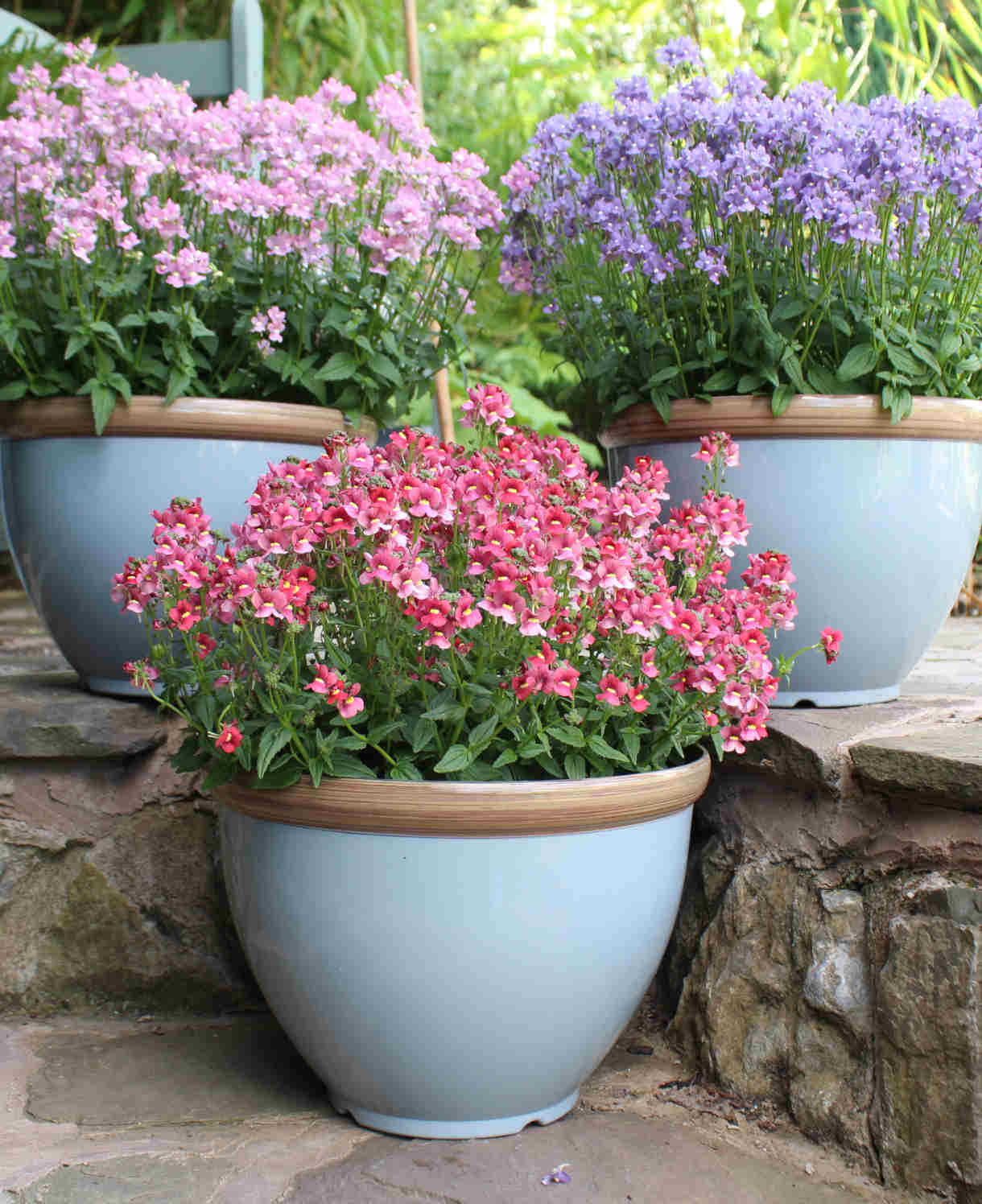
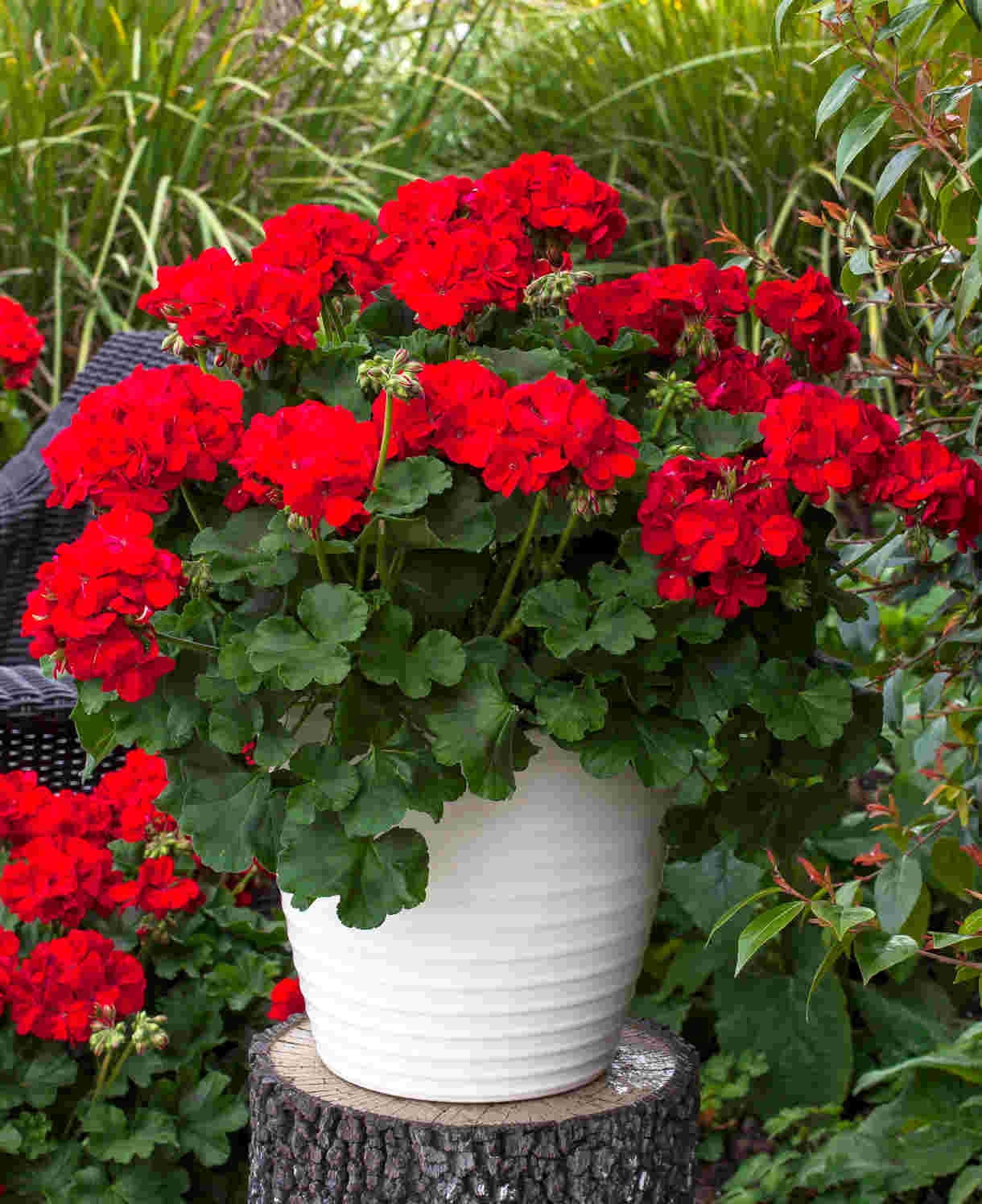

How to care for Petunia
Pruning and Deadheading
No pruning is necessary on these plants, however if the tops are becoming flat and bare you can give them a light mid-season shearing to generate new, bushy growth.
Surfinia petunias will naturally shed spent flowers, however the neat and tidy among us can help the process along by regularly pinching off any which are beginning to wither.
It is possible to keep petunias for the following year, however they tend not to be as vigorous and floriferous. That coupled with the affordability of new plants means most gardeners prefer to remove them to the compost heap in autumn and start afresh in spring. If you do wish to give this a go, however, cut the plant back to around 5 centimetres in September/ October, water, then move into a warm, frost free environment such as a heated greenhouse or well-lit windowsill. Check now and again, watering just enough to prevent the compost drying out completely. In spring, give a good soak to trigger a return to growth. Harden off and move outside as above.
Another option is to take cuttings and grow your own replacement plants. See Propagation section below.
Watering
Surfinia petunias are thirsty plants which can be watered freely during dry weather. Aim for consistently moist but not soggy soil/ compost.
A saucer placed under a container can be a great help in maintaining moisture in the compost, though even with this in place be aware that containers can need watering as often as once a day when conditions are hot (more if the container is very small or full). In the ground, a generous layer of mulch on planting is an effective way of locking water in the soil (see next section).
Feeding
To get the most out of hungry summer bedding plants such as Surfinia petunias, regular feeding is a must – particularly when grown in containers.
In a container, use a good quality compost with slow-release fertiliser granules mixed in. These generally provide enough nutrients for around 6 weeks, after which a liquid feed every 2 weeks can make a big difference to performance. Go for one high in potassium (such as tomato food) to encourage maximum flowering.
In the open ground, mulch newly planted Surfinia petunias with a decent layer of well-rotted organic matter, i.e., manure or garden compost applied to the soil around the plant. As well as boosting the nutrient content of the soil, this has the added benefit of suppressing weeds and locking in moisture. After this, you can either leave the plant to its own devices (fine on healthy, fertile soil), or apply a high potassium liquid feed as described above (beneficial on poor or sandy soil).
Cold Protection
Surfinia petunias will not survive a UK winter outdoors. Either remove to the compost heap (having taken cuttings if you want to maintain your stocks – see Propagation section below) or overwinter indoors as described in the Pruning and Deadheading section above.
Pests and Diseases
Surfinia petunias are largely trouble-free, however you may find the soft, new growth susceptible to slug and snail damage. It is worth growing plants on indoors for a little while so they are larger and less vulnerable when they go outside. Encouraging natural predators into your garden, such as birds, frogs, toads, and hedgehogs also makes a big difference. Torchlight searches after dark (when slugs and snails are at their most active) are also effective, allowing you to collect the offending molluscs in a bucket and dispose of as you see fit. Relocating to a nearby woods or bagging up and putting in your freezer before popping them in the bin are said to be the most humane approaches.
Aphids can also be an issue. As always, our advice is that these are part of a balanced garden ecosystem and the best approach is to leave them to their natural predators (e.g. birds, ladybirds, and wasps). When numbers are so large, however, that their feeding starts to inhibit and disfigure growth, you may feel it necessary to act. Regularly blasting off with a hose or wiping away with a cloth or piece of kitchen paper can help to keep numbers down without harming other insects.
How to propagate Petunia
Petunias can be tricky to propagate and, given their relative low cost, most gardeners prefer to buy them afresh each year. If, however, you wish to try your hand at propagating them, cuttings in late summer/ early autumn can be an option.
- Find non-flowered shoots 5-10cm long and snip off the plant.
- Put them in a plastic bag straight away to prevent drying out.
- Fill a container with a compost mix which is at least 50% perlite (or if you prefer, as we do, 100% perlite).
- Trim the end of the cutting to just below a node (point at which leaves grow).
- Remove the lowest third of leaves.
- If the remaining leaves are large, cut them in half with a sharp knife (to reduce water lost through transpiration).
- Insert the cuttings into the compost and water lightly. Several cuttings can be put in the same container if there is enough space to do this without them touching.
- Place in a propagating unit with bottom heat if you have one or covered with a plastic bag on a windowsill or in a greenhouse if not (out of direct sunlight).
- Keep the cuttings misted and occasionally watered until they root. You will know this has happened when roots emerge out of the bottom of the container.
- Gently remove rooted cuttings and pot them into individual pots. Grow on in a warm, frost-free environment such as a conservatory, greenhouse, or sunny windowsill, until it is safe to plant them out the following May.
* Many plants carry Plant Breeders Rights and cannot be propagated for commercial purposes.
Common Petunia questions
Are petunias easy to grow?
Spectacularly so! The advice given above will achieve best results, but in reality petunias are very tough and will tolerate a certain amount of neglect. They draw the line at drying out completely or being grown in full shade, but aside from this will have a good go at growing almost anywhere.
How long do petunias last?
In terms of flowering period petunias can bloom for up to six months of the year, particularly when deadheaded and fed regularly. Their overall lifespan is one growing season only, as they are either annuals or short-lived perennials treated as annuals.
What month is best to plant petunias?
Never plant petunias outside when there is still a risk of frost. For most of the UK this risk passes in May, though can be earlier or later depending on where you are. See our ‘When and where to plant petunias’ section above for more information.
What is the best fertiliser for petunias?
We recommend a high potassium liquid feed, such as tomato feed, to encourage flowering. See our ‘Feeding’ section above for more information.
How often should I water petunias?
As often as it takes to maintain a consistent level of moisture in the compost or soil. In a densely planted container, this might mean as often as once a day during hot weather. Follow our guidance in the ‘Watering’ section above to help avoid overwatering, which can be as harmful to plant health as underwatering!
Can you grow Surfinia petunias as houseplants?
Yes, as long as you can offer somewhere with plenty of light (at least six hours per day). This means an area with lots of windows such as a greenhouse, conservatory, or sunny porch.
Can you get smaller-flowered petunias?
Petunias have large, trumpet-shaped flowers and Surfinia petunias produce some of the biggest. For smaller blooms, try close relative calibrachoa, also known as million bells.
How do I get my petunia to bloom as early as possible?
Go for one of the newer, even earlier flowering varieties of Surfinia petunia such as ‘Trailing Red’, ‘Trailing Ocean Blue’, or ‘Trailing Light Yellow’. These get going up to two weeks earlier than classic types.
